
Cover Sheet
Teacher Example
- Subject:
- Education
- Elementary Education
- English Language Arts
- History
- Mathematics
- Physical Science
- Social Science
- Material Type:
- Activity/Lab
- Date Added:
- 07/06/2019

Cover Sheet
Teacher Example
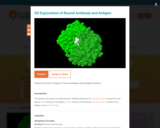
Explore the role of shape in how antibodies and antigens interact.

This comprehensive Open Source lesson plan is designed for Kindergarten through Middle School level students to learn about life cycles, plants needs, and plant structures & their functions through hands-on investigations with Wisconsin Fast Plants. Depending on the grade level, students engage at an appropriate depth with developing models and constructing arguments that plants have internal and external structures that function to support survival, growth, behavior, and reproduction. This lesson is available as a Google Doc in the Gather, Reason, Communicate instructional model. You may copy the lesson Doc to your own Drive and edit/adapt for your own use--it is shared by the Fast Plants Program as an Open Education Resource" therefore, you are free to use and adapt for noncommercial purposes, provided you attribute the Wisconsin Fast Plants Programs website (www.fastplants.org) as your source and share openly (for noncommercial purposes) any materials you develop with ours.

This resource was created by Judy Prewett, in collaboration with Dawn DeTurk, Hannah Blomstedt, and Julie Albrecht, as part of ESU2's Integrating the Arts project. This project is a four year initiative focused on integrating arts into the core curriculum through teacher education, practice, and coaching.
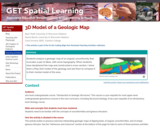
Play-Doh model of a geologic map
Provenance: Carol Ormand Ph.D., Carleton College
Reuse: This item is offered under a Creative Commons Attribution-NonCommercial-ShareAlike license http://creativecommons.org/licenses/by-nc-sa/3.0/ You may reuse this item for non-commercial purposes as long as you provide attribution and offer any derivative works under a similar license.
Students analyze a geologic map of an angular unconformity that truncates a pair of dikes, with some topography. When students have deciphered the map and constructed a cross-section, I show them a Play-Doh model of the geology and ask them to compare it to their mental model of the area.
(Note: this resource was added to OER Commons as part of a batch upload of over 2,200 records. If you notice an issue with the quality of the metadata, please let us know by using the 'report' button and we will flag it for consideration.)
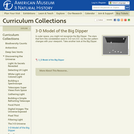
Students see firsthand that stars and constellations are not arranged in a flat, 2-D pattern in this Moveable Museum unit. The five-page PDF guide includes suggested general background readings for educators, activity notes, step-by-step directions, and a Big Dipper map. Students make their own 3-D models of the Big Dipper using readily available materials and examine their models, observing the 3-D constellation from new perspectives.
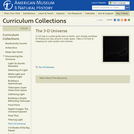
A 2-D map is a great guide here on Earth—and virtually worthless for finding your way around in outer space. Take a 3-D look at mapping our solar system and universe. This Moveable Museum article, available as a printable PDF file, looks at how astronomers use data to create 3-D models of the universe. Explore these concepts further using the recommended resources mentioned in this reading selection.
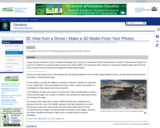
Using cameras mounted to drones, students will design and construct an experiment to take enough photos to make a 3-dimensional image of an outcrop or landform in a process called structure from motion (SfM). This activity has both a hands-on component (collecting data with the drone) and a computer-based component (creating the 3-dimensional model).___________________Drones can take photos that can be analyzed later. By planning ahead to have enough overlap between photos, you take those individual photos and make a 3-dimensional image!In this activity, you guide the students to identify an outcrop or landform to study later or over repeat visits. They go through the process to plan, conduct, and analyze an investigation to help answer their science question.The Challenge: Design and conduct an experiment to take enough photos to make a 3-dimensional image of an outcrop or landform, then analyze the image and interpret the resulting 3-d image.For instance they might wish to study a hillside that has been changed from a previous forest fire. How is the hillside starting to shift after rainstorms or snows? Monitoring an area over many months can lead to discoveries about how the erosional processes happen and also provide homeowners, park rangers, planners, and others valuable information to take action to stabilize areas to prevent landslides.
(Note: this resource was added to OER Commons as part of a batch upload of over 2,200 records. If you notice an issue with the quality of the metadata, please let us know by using the 'report' button and we will flag it for consideration.)

Children creat a 3 dimensional model of various constellations to learn how 2d images are actually 3d.

Learn how honey bees work together as a hive to provide for their own needs while pollinating our planet's flowers! This lesson includes learning objectives, material and resource lists, background information, activities, reading selections, writing assignments, a game, assessments, and support documents. See the Educator's Guide for more video links and recommended readings.

This is a task neutral proficiency scale for 3-PS2-1. Resources used to make this: NGSS.NSTA.org, Appendix E from the NextGenScience site and the actual performance expectations. This scale was created through collaboration with five elementary teachers.
Note: Proficiency scales assume learning progression. A student that can independently plan and conduct an investigation could be building off a collaborative investigation by changing their variables.

In this lesson, students expand their understanding of solid waste management to include the idea of 3RC (reduce, reuse, recycle and compost). They will look at the effects of packaging decisions (reducing) and learn about engineering advancements in packaging materials and solid waste management. Also, they will observe biodegradation in a model landfill (composting).

Interested in research but can't find any opportunities? Look no further! Check out these quick strategies for getting started with research!
Learning Outcomes:
Identify three strategies for finding research opportunities.

This resource is a video abstract of a research paper created by Research Square on behalf of its authors. It provides a synopsis that's easy to understand, and can be used to introduce the topics it covers to students, researchers, and the general public. The video's transcript is also provided in full, with a portion provided below for preview:
"Climate change is altering our world as we know it. Unfortunately, there’s no one-size-fits-all solution for making our environment resilient. From planners to scientists to farmers and ranchers, the lens through which climate change is viewed is dynamic. So how can anyone plan the best course of action with the best available data? Researchers led by Aavudai Anandhi at Florida A&M University might have just the right tool for the job. Their evidence-based approach combines three climate research methods to tailor action plans to the needs of a given ecosystem—whether that’s an entire country or state, or a single community, and whether for now or for the future. The approach begins with gathering evidence of climate change over a geographical region—the state of Florida for example. That’s done by pulling from trusted research to understand how factors like temperature or rainfall have evolved or are projected to evolve over time..."
The rest of the transcript, along with a link to the research itself, is available on the resource itself.

This resource is a video abstract of a research paper created by Research Square on behalf of its authors. It provides a synopsis that's easy to understand, and can be used to introduce the topics it covers to students, researchers, and the general public. The video's transcript is also provided in full, with a portion provided below for preview:
"Climate change is altering our world as we know it Despite general guidelines for mitigating harmful changes Climate change affects different areas in different ways And those effects aren’t always clear Now, a new evidence-based tool could provide the resolution to tailor plans of action around the globe It starts with a meta-analysis that gathers climate change data for a given ecosystem That data provides the input needed to draw conclusions about future climate trends, or scenarios Such as increases or decreases in temperature The effects those changes are likely to set in motion are then linked together in a causal chain Which can reveal how crops, natural resources, or animal species will fare amid climate change Although the tool becomes limited when data for a given area are scarce It could be a powerful new way to develop custom-made plans for fighting climate change.."
The rest of the transcript, along with a link to the research itself, is available on the resource itself.

The attached lesson plan is designed for 3rd grade English Language Arts students. Students will analyze informational text to determine the main ideas for a report, apply the concepts of the writing process, and communicate their research through an oral presentation to their classroom peers. This lesson plan addresses the following NDE Standards: NE LA 3.1.6.e, NE LA 3.2.1.a,c,d,e,j, NE LA 3.3.1.aIt is expected that this lesson plan will take five one-hour sessions to complete.
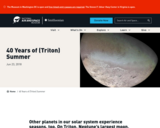
On Triton, Neptune's largest moon, seasons last an average of 40 years, complete with nitrogen snow. Here's how Triton's summer solstice compares to Earth's.

This is an extension activity after discussing cancer or lead into discussing about student choices. Essential QuestionsStudents will be able to to describe behaviors lead to skin cancer and how can it be prevented.Students will be able to explain the risk and reward behaviors.
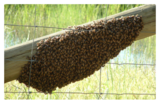
Learn how honey bees manage their community through swarming. This lesson includes learning objectives, material and resource lists, background information, activities, reading selections, writing assignments, a game, assessments, and support documents. See the Educator's Guide for more video links and recommended readings.
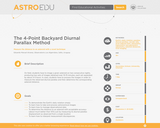
On field, students have to image a given asteroid on two consecutive nights, producing two sets of images obtained over 10-15 minutes, each set separated by about 4-5 hours. In class, students have to process the images in order to measure the observed diurnal parallax and then determine the corresponding asteroid distance.